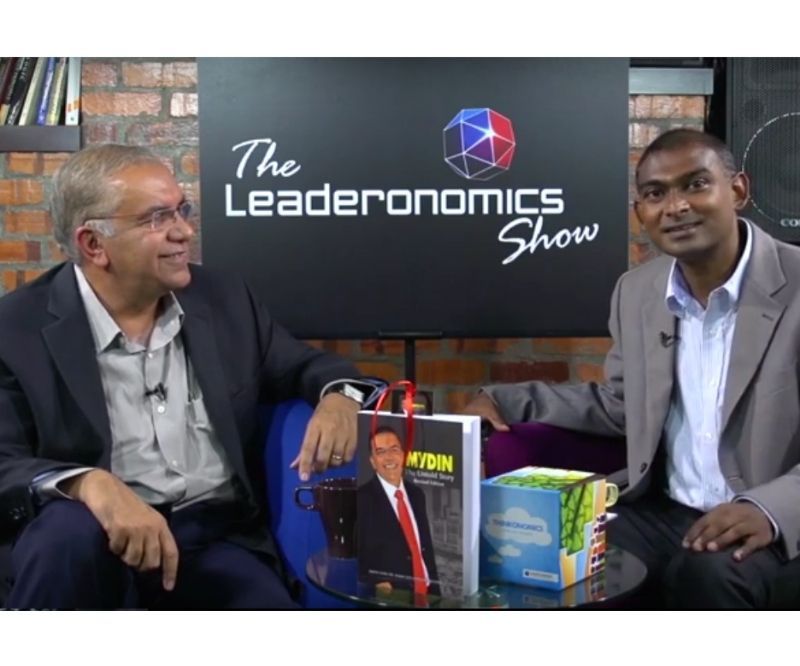How to Empower HR in the Digital Age: 7 Insights for 2025 (Part 2)

Macrovector from Freepik
Explore the speaker decks from HR Tech Conference & Expo 2025 here.
Continuing our coverage of the HR Tech Conference & Expo 2025 series, this second installment dives deeper into how HR can evolve and lead in today’s fast-changing digital landscape.
From elevated self check-in kiosks, brain science, to unexpected lessons from a Disney World rollercoaster, each perspective reveals a clear pattern: meaningful transformation in HR comes from paying closer attention to how people feel, make decisions, and respond to change.
In case you missed Part 1, read here.
1. Break Free from the Procrastination Trap
Darvin Widjaja, Managing Director of Momenta Indonesia

Darvin Widjaja
When everyone has access to the same AI tools and technologies, the real advantage lies in who can use them best. But embracing change is never easy.
Darvin offered a timely reminder that even the biggest companies can fall. Of the original Fortune 500 companies from 1955, only 51 remain today. In Indonesia, digital unicorns are collapsing. Beloved brands like BlackBerry and Tupperware also show that legacy alone isn't enough to withstand disruption.
Moreover, what initially seems trivial and gets dismissed often leads to a company’s downfall. Darvin identified the procrastination trap as the main obstacle to adopting new technologies like AI. This trap manifests as:
- A lack of discipline in adopting new tools and processes
- Viewing change as painful
- Fear of humiliation from failure
While the typical response is for HR to prioritise keeping people comfortable, Darvin argues that true learning and growth happen in a state of discomfort. To drive AI adoption, HR must help people move from the comfort zone into the courage zone. HR’s role, he says, isn’t to make people happy all the time, but to make them happy in the end. Once competitiveness leads to eventual business growth.
He outlines three key types of courage that HR and leaders must cultivate:
- Courage to Try: Encourage experimentation and risk-taking, even in large, traditional organisations.
- Courage to Trust: Trust people, processes, leaders, and tools. Accepting that failure is part of the journey.
- Courage to Tell: Create a culture where people feel safe to speak up and challenge ideas, even those of their leaders. This involves building ‘safety for everyone’ through training, culture, and KPIs so people feel empowered to try, fail, learn, and repeat.
This is the cycle necessary not just for innovation, but for lasting AI transformation.
2. Human-Centered AI Through Design Thinking
Giorgio Catucci, Leadership Coach & Business Transformation Expert

Giorgio Catucci
Drawing on his multidisciplinary background, Giorgio suggests that successful AI implementation extends beyond mere technical functionality to deeply understanding the user's journey.
After 10 years of helping companies implement IT systems, he observed that most failures occur when companies prioritise processes over people. When the learning experience isn't engaging, it becomes a burden.
This is why he introduced Design Thinking as a creative, user-focused approach to redesigning experiences. At the heart of this method is empathy; not just understanding what users want, but grasping their thoughts, emotions, motivations, and the full spectrum of their ‘pains’ and ‘gains’.
It’s not just about streamlining steps, but improving how people feel when they interact with technology.
For instance, Virgin Atlantic goes further than just saving time with the self check-in kiosks. They add flowers, music, and nice lighting, turning a basic task into a pleasant experience. This small investment transforms a mundane task into a pleasant encounter, demonstrating that improving enjoyment can be more impactful than pure technical optimization.
AI solutions, too, should be more than efficient—they should also understand, connect, and enhance the human experience.
Read: How to Embed AI in Your Organisational DNA
3. Mindful Leadership at Machine Speed
Dr. Avnesh (Avi) Ratnanesan, Founder of Dr Avi Global

Dr. Avnesh (Avi) Ratnanesan
What if in the future, AI will not only be ‘agents’ assisting tasks but will evolve into ‘employees’ with human-like characteristics?
Bill Gates predicted this. Particularly the idea of a two-day work week due to AI’s impact.
Dr. Avi, too, firmly believes that the future of humans and AI agents are inevitable. In fact, he appointed his own company’s AI, ZeroCEO, as the co-founder and co-CEO. The AI attends meetings and assists in strategic decisions.
When presented with a whirlwind of daily tasks (HR meetings, client proposals, personal errands, addressing an upset team member), ZeroCEO instantly prioritised them, broke them down, and suggested actionable steps—demonstrating how AI can exponentially accelerate a leader's ability to focus and make high-value decisions.
But this isn't just about efficiency. It challenges the very definition of leadership and work.
If AI can think strategically, prioritise emotionally charged situations, and take on a co-founder role—what then becomes uniquely human?
Rather than replacing leaders, AI may redefine what good leadership looks like. Not in terms of controlling outcomes, but in choosing what matters, when to act, and how to stay grounded in values while moving at machine speed.
Dr. Avi introduced NAIL (Neuroscience and AI Optimised Leadership) as the solution to develop this critical skill, enabling leaders to optimize their brains and leverage AI for business growth. NAIL has two main components:
1. Neuro Focus: Understanding how the brain processes decisions. When facing an opportunity or problem:
- Neocortex: Processes facts (e.g., the benefits of AI or cost savings).
- Limbic System: Processes emotions (e.g., excitement, fear, or feeling overwhelmed).
- Brain Stem: Processes survival instincts (e.g., fear of being replaced by AI). Decisions made from this complex cognitive processing directly impact profit or loss. He used Steve Jobs' consistent attire as an example of optimizing decision-making capacity for higher-value product and customer focus.
2. Prompt Intelligence (PQ): This extends beyond prompt engineering to include knowing when and how effectively to use AI in daily work. PQ is presented as a crucial skill alongside IQ and EQ for future leaders.
The real frontier might not be building smarter AI, but becoming more intentional humans alongside it.
4. Rethinking the Cost of Potential in Talent Development
Ibrahim Sani, CEO of Yayasan Peneraju

Ibrahim Sani
In the digital age, HR is no longer just a support function—it’s becoming a strategic engine for national competitiveness. Few embody this bold shift more vividly than Ibrahim Sani, CEO of Yayasan Peneraju, who radically transformed a government talent agency by applying private-sector logic to public-sector HR.
Under his leadership, traditional scholarships were replaced by education loans. Talent development became less about subsidy, more about self-investment. Programs were narrowed to focus on growth industries like tech and finance, and digital capabilities were rapidly scaled.
Ibrahim believes that Malaysian talent lacks competitiveness. His approach aims to attract those with a desire to invest in themselves and remove those without.
To some, this feels like progress. To others, it signals a deeper shift from inclusive human development to performance-driven filtering.
This transformation invites an uncomfortable but necessary question:
In an era of speed, scale, and efficiency, what does it mean to truly empower talent?
As HR leaders adapt to the age of AI, data, and automation, Ibrahim’s story becomes a case study in how digital-age mindsets are reshaping the very foundations of workforce strategy.
Read: Culture Drift: When AI Moves Faster Than Trust
5. Treat Your Employees Like Customers
Dennis Akkerman, Founder & Managing Director of Orbis Business School

Dennis Akkerman
Integrating HR with tech often feels like adding digitalized extra steps than creating efficiency. Similar to Giorgio, Dennis highlighted the ‘broken employee journey’ where HR tech often fails—from overly complicated job application forms, fragmented learning platforms, to using user-unfriendly tools.
Dennis’ central diagnosis was that "HR people are from Venus, and tech people are from Mars”. He stressed the need to bring these worlds together.
In doing so, he turned to marketing’s customer journey framework as common ground for both worlds:
- Awareness: What do people say about your company even before vacancies exist?
- Attraction: How actively do you promote your employer brand to draw in talent?
- Empathy: Are you seeing employees as internal customers with real needs?
Just like consumer apps, HR tech must be engaging, intuitive, and responsive. If you want feedback, you need to design systems employees want to interact with. Dennis offered practical examples of how this mindset translates into action:
- Recruitment: Provide continuous communication to applicants throughout the process (like Amazon's delivery updates) to avoid losing potential future employees.
- Talent Development: Use APIs to connect siloed learning platforms and create a holistic view of development.
- Performance Management: Develop user-friendly, mobile-friendly tools for managers and employees.
- Offboarding: Implement systems that can instantly revoke all digital and physical access when someone exits.
6. The Essential Art of Heart to Heart Connection
Jonathan Low, Global Conference Keynote Speaker & Leadership Coach

Jonathan Low
Jonathan opened his session by taking the audience down memory lane when he went to Disney World. He reminded the audience how scary it was to ride the Expedition Everest; its pitch-black tunnels, sharp twists, and sudden drops.
Jonathan isn’t even a fan of rollercoasters. He eventually gave in out of FOMO (fear of missing out). He faced his fear not because he wasn’t scared, but because he didn’t want to be left behind.
In many ways, that’s how AI transformation feels for leaders and organisations today. The ride is unfamiliar. The turns are sharp. And the fear is real.
But confidence isn’t always what gets us moving. Sometimes, it’s the people beside us. The ones who believe, who encourage, and who care.
That’s why Jonathan introduced the CARE framework—a guide for leaders to bring more human connection into the age of AI:
C – Connect
Real connection starts with presence. Jonathan described four levels of workplace relationships:
- Autopilot: Habitual check-ins (e.g., “How are you?” “Have you had breakfast?”).
- Transmit: One-way communication, like broadcasts.
- Engage: Human interaction without leveraging tech.
- Amplify: When tech enhances human connection.
A – Adaptability
Adaptability isn’t about knowing what to do, it’s about responding with purpose. Jonathan shared Jack Canfield’s formula: E + R = O (Event + Response = Outcome).
He challenged leaders to embody adaptability through:
- Ability
- Character (grit, flexibility, resilience)
- Environment (culture that supports change)
R – Relationships
Even in a high-tech world, people remember how you make them feel. Jonathan cited Hai Di Lao, a restaurant that introduced robots but also doubled its human staff to enhance customer experience through manicures, hand massages, live noodle-stretching performances, and more.
He shared the Four Cs of Trust:
- Competence: in both tech and people skills.
- Commitment: to meaningful connection.
- Consistency: in behavior, words, and follow-through.
- Care: the most powerful and often forgotten.
E – Empathy
Finally, Jonathan emphasized empathy as a daily practice. He invited leaders to ask:
“How do you show others that you value beyond what they produce?”
7. From Content Delivery to Behavioral Transformation
Arun Nagarajah, CEO & Founder of eVULX International & TalentStore

Arun Nagarajah
Netflix, TikTok, and Youtube are changing the way people consume content. The new attention economy is a reality that L&D companies must face other than its crowded market.
Arun argued that in this landscape, effective learning must do more than inform—it must transform. It’s not about delivering content; it’s about shifting behavior and anchoring knowledge in memory.
At eVULX, this transformation is guided by four core elements:
- Experiential Learning: Learning that feels personal and visceral.
- Emotional Engagement: Tapping into empathy, tension, and decision-making under pressure.
- Authentic Storytelling: Based on real events, told with care and nuance.
- Netflix-Level Production: Visuals, sound, and pacing that rival entertainment platforms.
To illustrate the impact, Arun spotlighted Shadows of Medellin, a flagship episode from Inside Risk series. Based on a real-life kidnapping in 1980s Colombia, the experience places participants in the shoes of a manager negotiating for a hostage’s release.
While literal kidnappings are rare in the workplace, Arun pointed out the metaphorical truth behind the story:
“We’re all held hostage sometimes—by pressure, by difficult bosses, by fear.”
The scenario challenges learners to build trust, solve problems creatively, and stay grounded under stress. More than just ‘training’, it’s an experience with emotional stakes that stick.
In a digital world, attention is fleeting, but emotion lingers. When training connects with the heart, it drives action. And that, Arun believes, is the future of L&D.
Step Into the Room Where Leaders Grow
Leadership
Tags: Digital, Artificial Intelligence, HR, Executing Leadership, Crucible Moments, Consultant Corner, Competence, Companies
Anggie is the English editor at Leaderonomics, where creating content is an integral part of her daily work. She is never without her trusty companion: a steaming cup of green tea or iced latte.






